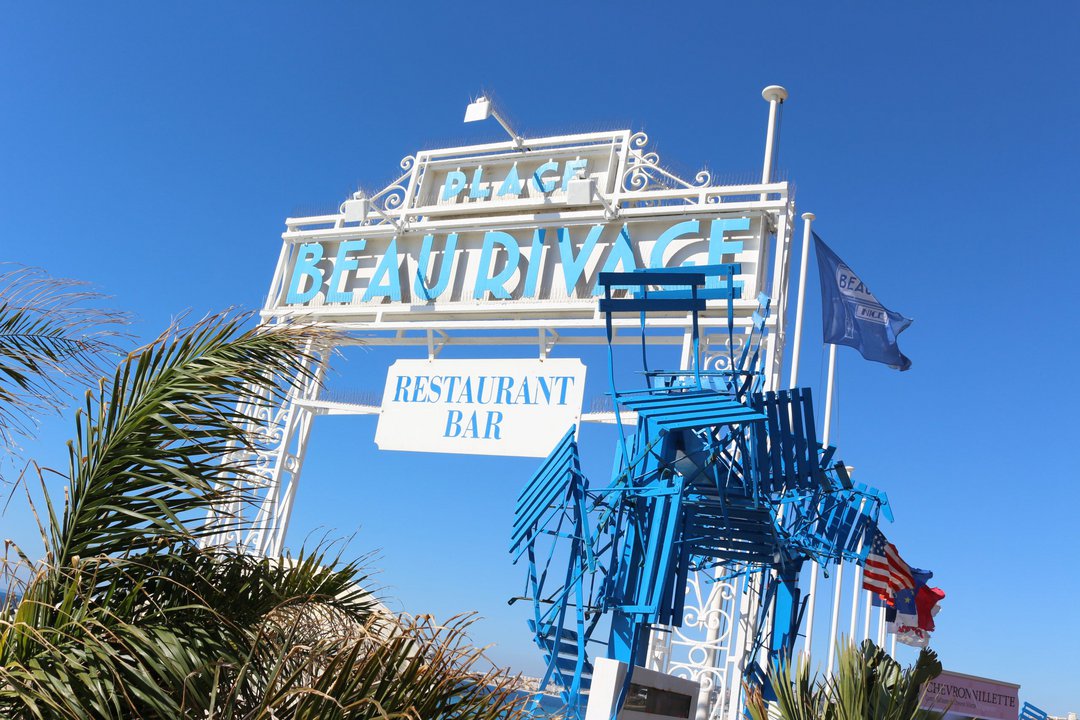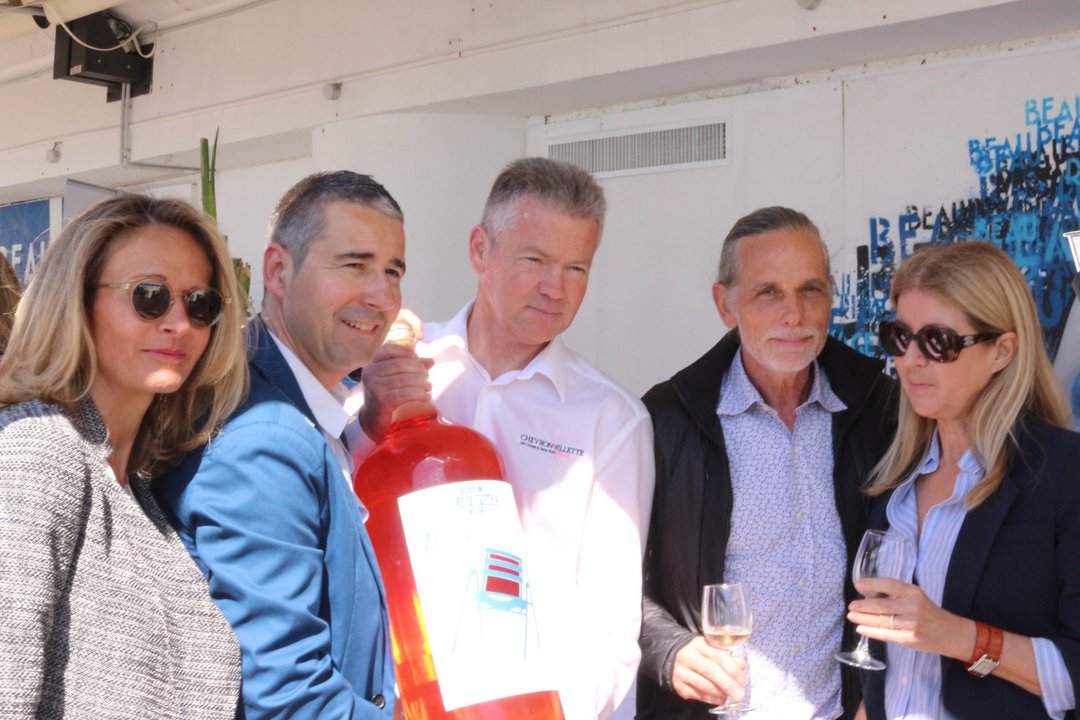Rosé Pink and Azur Blue – the launch of a new brand for the Côte d’Azur
 I was intrigued when I first saw the publicity for a rosé wine bearing an image of the iconic chaise bleu of the Promenade des Anglais on Nice’s Côte d’Azur waterfront.
The launch of this new label Prose was at the lovely Plage Beau Rivage, by the Promenade des Anglais in Nice. This describes itself as "the best place to be for a meal with sea-view, a drink between friends, a live clubbing evening or if one wants to make the most of the sun on a sunbed".
Made by the Comte Guillaume de Chevron-Villette, owner of Château Reillanne, one of the largest winemakers in Provence, Prose is the latest in its range, and is targeted at the on-trade and wine-merchants. A pleasant, delicately fruity summer quaffing wine, made largely from Grenache and Cinsault with small percentages of Rolle and Tibouren. Despite the Niçois image, the wine is not from Bellet, the wine appellation of Nice, but is Côtes de Provence from central Provence.
The launch party included a raffle for a Nice football team t-shirt, a machine taking photos of attendees, local socca crisps from Luc Saledo, and lunch-time snacks. We were blessed by a perfect spring day with temperatures of nearly 20°C, bright blue azure skies and a wonderful setting metres from the water’s edge.
The label of Prose depicts the two-dimensional sculpture of the blue chair of Nice by local artist SAB (Sabine Géraudie), with a cut-away design revealing the pink wine behind, described in the publicity as the pink skies of a Nice sunset. The statue was unvelied in October 2014. Measuring 3 metres in height, it stands opposite the Jardin Albert 1er.
I was intrigued when I first saw the publicity for a rosé wine bearing an image of the iconic chaise bleu of the Promenade des Anglais on Nice’s Côte d’Azur waterfront.
The launch of this new label Prose was at the lovely Plage Beau Rivage, by the Promenade des Anglais in Nice. This describes itself as "the best place to be for a meal with sea-view, a drink between friends, a live clubbing evening or if one wants to make the most of the sun on a sunbed".
Made by the Comte Guillaume de Chevron-Villette, owner of Château Reillanne, one of the largest winemakers in Provence, Prose is the latest in its range, and is targeted at the on-trade and wine-merchants. A pleasant, delicately fruity summer quaffing wine, made largely from Grenache and Cinsault with small percentages of Rolle and Tibouren. Despite the Niçois image, the wine is not from Bellet, the wine appellation of Nice, but is Côtes de Provence from central Provence.
The launch party included a raffle for a Nice football team t-shirt, a machine taking photos of attendees, local socca crisps from Luc Saledo, and lunch-time snacks. We were blessed by a perfect spring day with temperatures of nearly 20°C, bright blue azure skies and a wonderful setting metres from the water’s edge.
The label of Prose depicts the two-dimensional sculpture of the blue chair of Nice by local artist SAB (Sabine Géraudie), with a cut-away design revealing the pink wine behind, described in the publicity as the pink skies of a Nice sunset. The statue was unvelied in October 2014. Measuring 3 metres in height, it stands opposite the Jardin Albert 1er.

SAB's statue of La Chaise Bleu, unveiled in 2014
The entrance to the Plage Beau Rivage is an arch made from blue chairs, located metres from the Chaise Bleu sculpture.
 With blue chairs such a dominant theme, I was curious to know more about this feature of the Nice beach-front.
With blue chairs such a dominant theme, I was curious to know more about this feature of the Nice beach-front.
 The name, ‘Côte d’Azur’ was created in 1888 by Stéphen Liégeard in his eponymous book la Côte d’Azur. Liégeard, who had spent every winter in Cannes, was inspired by the brilliant blue of the sky and sea, so described it as the blue coast or ‘la Côte d’Azur’.
Trains had been bringing tourists to the south coast since the 1860s. Originally only the wealthy came, and these have always had an important place in the Côte d’Azur. In 1922 a new luxury all-steel train was introduced for them, painted azur blue, colloquially known as le Train bleu. The Marie Christine bottle by Domaine Fabre was designed for the train. This night-express with such high standards of luxury attracted such an exclusive clientèle it was nicknamed "the millionaires’ train". Tourists increasingly came to the Côte d’Azur, not just for the warm winters but also increasingly for the summers.
The name, ‘Côte d’Azur’ was created in 1888 by Stéphen Liégeard in his eponymous book la Côte d’Azur. Liégeard, who had spent every winter in Cannes, was inspired by the brilliant blue of the sky and sea, so described it as the blue coast or ‘la Côte d’Azur’.
Trains had been bringing tourists to the south coast since the 1860s. Originally only the wealthy came, and these have always had an important place in the Côte d’Azur. In 1922 a new luxury all-steel train was introduced for them, painted azur blue, colloquially known as le Train bleu. The Marie Christine bottle by Domaine Fabre was designed for the train. This night-express with such high standards of luxury attracted such an exclusive clientèle it was nicknamed "the millionaires’ train". Tourists increasingly came to the Côte d’Azur, not just for the warm winters but also increasingly for the summers.

Painting by Yves Klein, 1955 During the 1950’s, a new influx of international visitors started to arrive and the town of Nice ordered 800 new chairs to be put out along the Promenade des Anglais, from Monsieur Ballanger, who held the concession for renting these out there. Ballanger commissioned local designer Charles Tordo, who lived in Tourrette-Levens in the hills above Nice, to create a chair. Tordo's design used local beech and plane-tree wood, from local forests, bolted to a metal frame. The chairs were originally painted white, but were changed to a particular, intense shade of blue which was then in vogue, partially thanks to the Niçois artist Yves Klein, whose blue monochrome paintings were inspired by the sea and sky of Nice.
Over the years the design of the chairs along the Promenade has been modified, but the colour blue has remained. The present model, redesigned in 1996 by the French designer and architect, Jean-Michel Wilmotte (who also designed the Allianz Riviera sports stadium in Nice), is painted a lighter sky blue, to ‘complement the azure waters of the Baie des Anges’.
 Over time chairs were stolen, then others in 2000 were used in riots. For security, the individual chairs were removed and replaced with lines of ten to twenty azure-blue chairs, joined together and fixed to the Promenade facing the sea. (The same blue is also used for the rental bikes and street furniture around Nice).
In the publicity, SAB enthuses about rosé wine and Prose. In return the wine promotes SAB's art.
Over time chairs were stolen, then others in 2000 were used in riots. For security, the individual chairs were removed and replaced with lines of ten to twenty azure-blue chairs, joined together and fixed to the Promenade facing the sea. (The same blue is also used for the rental bikes and street furniture around Nice).
In the publicity, SAB enthuses about rosé wine and Prose. In return the wine promotes SAB's art.

At the launch: SAB (left), le Comte de Chevron-Villette (centre)
But how many people, outside the region, know that the Chaise Bleu is a symbol of the Côte d’Azur in Nice? How many will see the label as simply a blue chair? While the packaging was great publicity for SAB in promoting her chair, and may be popular in tourist venues in Nice, I was left wondering what is different about the wine, and what it offers the consumer. What is different about this rosé, say, compared to other brands linked to local tourism such as ‘St Tropez’ or ‘SandTropez’? I am not sure.
This rosé joins the ranks of pink wines tapping into the leisure and tourist image of the south of France. It is pleasant, attractively presented, and, at the right price, will sell.
